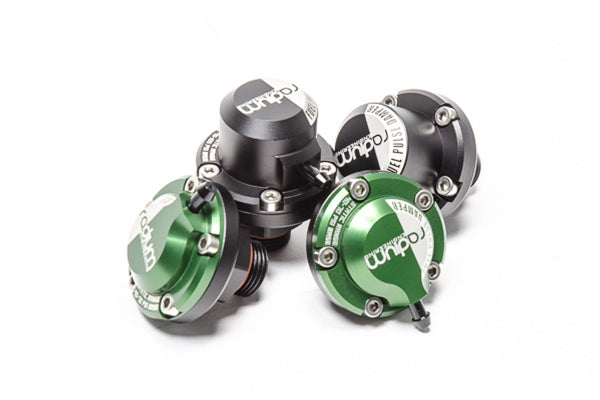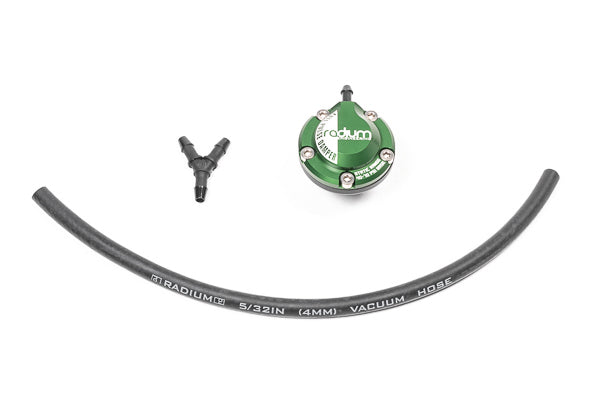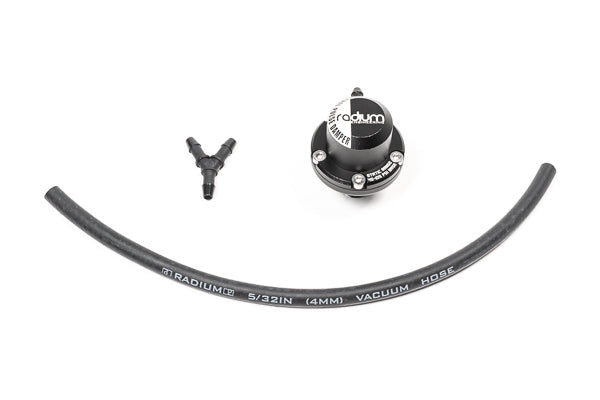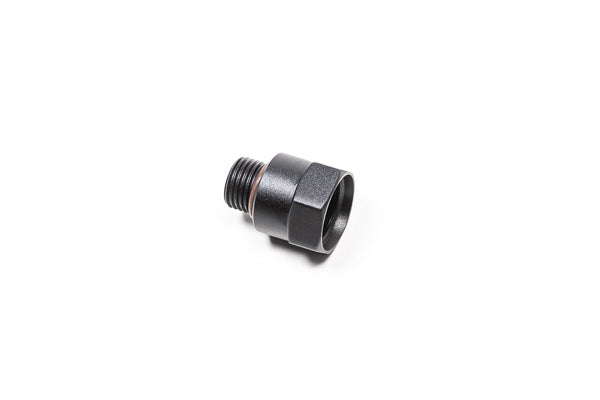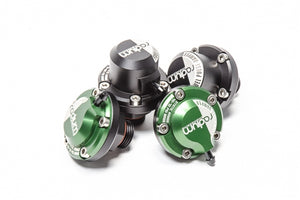
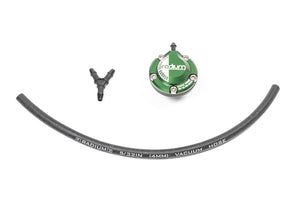
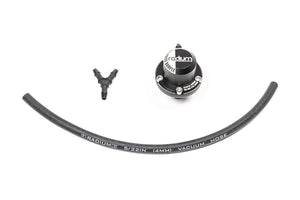
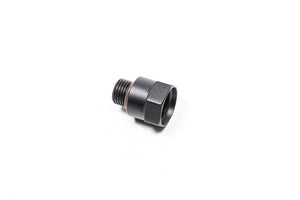




COMPATIBILITY
- Connection to any 8AN ORB or 3/8" NPT female threaded port
- Connection to any 6AN ORB female threaded port (with optional adapter)
Use the dimension data in the description to assure you have space for the damper around your port.
DAMPERS CAN NOT BE USED ON THE LOW PRESSURE SIDE OF MECHANICAL FUEL PUMPS (INCLUDING DIRECT INJECTION ENGINES).
OVERVIEW
The opening and closing of fuel injectors creates pressure pulses in the fuel rail; this can lead to unstable fuel pressure. In order to achieve a safe and consistent rail pressure, a fuel pulse damper (FPD) is often necessary. The FPD's internal diaphragm will absorb oscillating pulses and stabilize fuel pressure. This correction can be measured throughout the RPM range and can often help idle surge, especially with high flow injectors. Furthermore, a fuel pulse damper can help solve erratic lean air/fuel ratio spikes, commonly experienced as 'stumbling', that are difficult to tune out.
Fuel pulse dampers can be mounted at any angle, including upside down. There are many variables that dictate if a fuel system requires fuel pulse dampers. For instance, there are cases where multiple dampers are necessary. There are also other times when the fuel system benefits with a fuel pulse damper on the return line.
This product is safe for use with all fuel types including alcohol blends such as E85.

 |
20-0776 FPD-R 8AN ORB Standard Operating Range: 40-70psi Standard operating range should be used on vehicles with a base fuel pressure between 40-70psi. If fuel pressure is static (does not fall or rise with manifold pressure) then no vacuum reference line is needed. If fuel pressure rises or falls lower or higher than the operating range, a vacuum line is needed. |
 |
20-0777 FPD-XR 8AN ORB Extended Operating Range: 40-105psi Extended operating range should be used on vehicles with a base fuel pressure above 70psi and up to 105psi. If fuel pressure is static (does not fall or rise with manifold pressure) then no vacuum reference line is needed. If fuel pressure rises or falls lower or higher than the operating range, a vacuum line is needed. |
 |
20-0178 FPD-R 3/8NPT Standard Operating Range: 40-70psi Standard operating range should be used on vehicles with a base fuel pressure between 40-70psi. If fuel pressure is static (does not fall or rise with manifold pressure) then no vacuum reference line is needed. If fuel pressure rises or falls lower or higher than the operating range, a vacuum line is needed. |
 |
20-0179 FPD-XR 3/8NPTExtended Operating Range: 40-105psi Extended operating range should be used on vehicles with a base fuel pressure above 70psi and up to 105psi. If fuel pressure is static (does not fall or rise with manifold pressure) then no vacuum reference line is needed. If fuel pressure rises or falls lower or higher than the operating range, a vacuum line is needed. |

|
14-0600 6AN ORB Male to 8AN ORB Female Use this adapter to adapt either of the 8AN ORB direct mount pulse dampers to a smaller 6AN port. |
UNIQUE DESIGN
Along with having the flexibility of using common fittings, Radium Engineering FPD's use a vacuum/boost reference port which allows for proper fuel pulse damper performance even at elevated fuel pressures. This becomes essential for boosted systems that use a 1:1 rising rate fuel pressure regulator and in vacuum referenced regulators when fuel pressure falls under 40psi.

HOW TO CHOOSE BETWEEN FPD-R VS FPD-XR
The FPD-R (Standard Range) and FPD-XR (Extra Range) both have unique base/static fuel pressure requirements:
- FPD-R base pressure requirement = 40 - 70psi (static)
- FPD-XR base pressure requirement = 40 - 105psi (static)
Base pressure is the fuel pressure measured when the fuel pump is running WITHOUT a vacuum line connected to the regulator.
You should choose the damper that has a range that covers your base fuel pressure. If your base fuel pressure does not exceed 70psi, there is usually no advantage to using the extra range unit. The exception to this would be if your rising rate pressure exceeds 70psi, but never exceeds 105psi, and your falling rate under vacuum never moves under 40psi. In this scenario, the extra range damper would allow you to run without a vacuum line where the standard would require one.

IMPORTANT: The ranges above are base static fuel pressures only. Any dynamic fuel pressure created by a rising-rate FPR outside of this range is acceptable, but only when the base "static" fuel pressure is set within these ranges and the vacuum/boost reference line is connected.
Example 1Vehicle: Mitsubishi EVO |
Example 2Vehicle: BMW E46 M3 |
FEATURES
- 8AN ORB versions seal using a FKM O-ring
- The 3/8' NPT variations seal with the tapered pipe threads (sealant should be used)
- Because 20-0178 and 20-0179 use tapered threads (NPT), the vacuum port can be clocked to the desired location during tightening
- Even after tightening, the newest 8AN ORB dampers (20-0776 and 20-0777) will swivel. This allows the vacuum port to be clocked 360 degrees.
INCLUDES
- Anodized and laser engraved aluminum top, R=range or XR=extra range
- Anodized aluminum body with male threads, 8AN ORB or 3/8" NPT
- Stainless steel hardware
- Rubber vacuum hose, 4mm ID
- Vacuum hose Y-fitting
TESTIMONIAL
Just wanted to say thank you a ton. That FPD-R solved every issue I had with lean spots in my entire rpm range after removing the stock damper a while back.
I even installed it on the return side of the rail near the regulator, and it didn't make a difference as you stated. This $85 part seriously just cured a $h!tload of hassle I've had; my tuner has tuned it all and couldn't tune these spots out. I only wish folks realized how important these are with certain fuel systems (namely upgraded systems still running batch injection vs sequential)
Thank you again. You rock!
- Dylan K.
Fuel Pulse Damper, Direct Mount Kits
- Regular price
- Sale price
- $0.00
- Regular price
-
Couldn't load pickup availability
